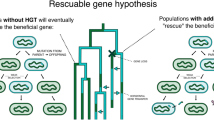Abstract
The control of transposable element copy number is of considerable theoretical and empirical interest. Under simple models, copy numbers may increase without limit. Mechanisms that can prevent such an increase include those in which the effect of selection increases with copy number, those in which the rate of transposition decreases with copy number, and those where unlimited increase in copy number is prevented by the consequences of functional heterogeneity in the transposable element family. Finite population sizes may attenuate the power of natural selection to act on transposable element copy number in a number of ways that may be of particular importance in laboratory populations. First, a small host population size will create occasional periods in which the variance between individuals in copy number is diminished, and with it the power of natural selection, even when the expected variance is Poisson. Second, small population sizes will produce high-frequency transposable element sites, systematically reducing the variance in copy number. The consequences will be particularly profound when the selective damage of transposable elements follows from their heterozygosity, as when ectopic exchange limits copy number.
Similar content being viewed by others
References
Aulard, S., F. Lemeunier, C. Hoogland, N. Chaminade, J.F. Brook-field & C. Biémont, 1995. Chromosomal distribution and popula-tion dynamics of the 412 retrotransposon in a natural population of Drosophila melanogaster. Chromosoma 103: 693–699.
Biémont, C., F. Lemeunier, M.P. Garcia Guerriero, J.F. Brookfield, C. Gautier, S. Aulard & E.G. Pasyukova, 1994. Population dynamics of the copia, mdg1, mdg3, gypsy and P transposable elements in a natural population of Drosophila melanogaster. Genet. Res. Camb. 63: 197–212.
Britten, R.J., W.F. Baron, D.B. Stout & E.H. Davidson, 1988. Sources and evolution of human Alu repeated sequences. Proc. Natl. Acad. Sci. USA 85: 4770–4774.
Brookfield, J.F.Y., 1982. Interspersed repetitive DNA sequences are unlikely to be parasitic. J. Theor. Biol. 94: 281–300.
Brookfield, J.F.Y., 1991. Models of repression of transposition in P-M hybrid dysgenesis by P cytotype and by zygotically-encoded repressor proteins. Genetics 128: 471–486.
Brookfield, J.F.Y., 1996. Models of the spread of non-autonomous selfish transposable elements when transposition and fitness are coupled. Genet. Res. Camb. 67: 199–209.
Charlesworth, B., 1985. The population genetics of transposable elements, pp. 213–232 in Population Genetics and Molecular Evolution, edited by T. Ohta and K. Aoki. Springer-Verlag Berlin.
Charlesworth, B. & D. Charlesworth, 1983. The population dynamics of transposable elements. Genet. Res. Camb. 42: 1–27.
Charlesworth, B. & C.H. Langley, 1986. The evolution of self-regulated transposition of transposable elements. Genetics 112: 359–383.
Deininger, P.L., M.A. Batzer, C.A. Hutchinson & M.H. Edgell, 1992. Master genes in mammalian repetitive DNA amplification. Trends Genet. 8: 307–311.
Doolittle, W.F. & C. Sapienza, 1980. Selfish genes, the phenotype paradigm and genome evolution. Nature 284: 601–603.
Eanes, W.F., C. Wesley & B. Charlesworth, 1992. Accumulation of P elements in minority inversions in natural populations of Drosophila melanogaster. Genet. Res. Camb. 59: 1–9.
Hoogland, C. & C. Biémont, 1996. Chromosomal distribution of transposable elements in Drosophila melanogaster: test of the ectopic recombination model for maintenance of insertion site number. Genetics 144: 197–204.
Kaplan, N.L. T. Darden & C.H. Langley, 1985. Evolution and extinction of transposable elements in Mendelian populations. Genetics 109: 459–480.
Langley, C.H., J.F.Y. Brookfield & M.L. Kaplan, 1983. Transposable elements in Mendelian populations. I. A theory. Genetics 104: 457–471.
Langley, C.H., E.A. Montgomery, R. Hudson, N. Kaplan & B. Charlesworth, 1988. On the role of unequal exchange in the containment of copy number. Genet. Res. Camb. 52: 223–235.
Montgomery, E.A. & C.H. Langley, 1983. Transposable elements in Mendelian populations. II Distribution of three copia-like elements in a natural population of Drosophila melanogaster. Genetics 104: 473–483.
Nuzhdin, S.V., E.G. Pasyukova & T.F.C. Mackay, 1996. Positive association between copia transposition rate and copy number in Drosophila melanogaster. Proc. Roy. Soc. Lond. B263: 823–831.
Orgel, L.E. & F.H.C. Crick, 1980. Selfish DNA: the ultimate parasite. Nature 284: 604–607.
Petrov, D.A., E.R. Lozovskaya & D.L. Hartl, 1996. High intrinsic rate of DNA loss in Drosophila. Nature 384: 346–349.
Quesneville, H. & D. Anxolabéhère, 1997. Dynamics of transposable elements in metapopulations: a model of P element invasion in Drosophila. In Press. Theoret. Pop. Biol.
Author information
Authors and Affiliations
Rights and permissions
About this article
Cite this article
Brookfield, J.F., Badge, R.M. Population genetics models of transposable elements. Genetica 100, 281–294 (1997). https://doi.org/10.1023/A:1018310418744
Issue Date:
DOI: https://doi.org/10.1023/A:1018310418744




